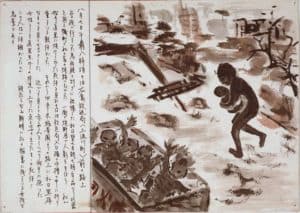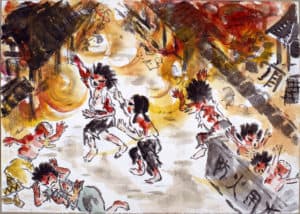On this day in 1945, the “Fat Man” atomic bomb was dropped over Nagasaki, raising the eventual death toll from the US’s nuclear war on Japan to 340,000 people. In contrast to the uranium Hiroshima bomb, the weapon cast over Nagasaki used powerful plutonium implosion, emitting a more damaging type of radiation.
The bomb was designed to explode above ground to maximize destruction. The heat emanating from the blast pulverised buildings and all life in its way. The city’s inhabitants experienced unimaginable suffering and devastation, survivors – hibakusha, or “explosion-affected people” – also endured the harrowing effects of trauma.
Those surviving witnessed the bomb-burned skin and charred bodies. Witnesses often speak of barely recognisable humans pleading for water, hoping to quench their radiation-induced thirst. Their suffering was compounded by a lack of medical care – 90% of medical staff in both cities were killed or disabled, and medical supplies were quickly exhausted. The pain of the hibakusha was prolonged for years, even decades, after the bomb due to increased susceptibility to leukaemia, cataracts and malignant tumours.
Many turned to art to document their experience. In 1974, the Japan Broadcasting Corporation (NHK) requested submissions of paintings and 2,225 drawings were produced by 758 survivors, a selection of which were exhibited worldwide. The insightful drawings are haunting evidence of the destructive power of nuclear weapons.




Many hibakusha were forced to keep their status hidden to avoid discrimination. The novelty of the bomb and public ignorance about the effects of radiation created a fertile ground for fear. Ignorance stemmed from censorship: the US enforced a strict press code denying radiation effects, and physicians were prohibited from publishing their findings.
Employers thought hibakusha might spread chronic illnesses in their place of work, while marriage prospects were eradicated by the suspicion that survivors’ afflictions could be hereditary. In the words of Keigo Miyagawa, “There were all sorts of rumours back then. My father kept changing where he lived, and the stories my mother told others kept on changing too. I had no idea what to do. But I did not say a word.” Some lost friends and family, who alienated themselves from the hibakusha. Many survivors of the Fukushima disaster have been facing the same discrimination, in spite of studies disproving these myths.
The bomb dropped over Nagasaki is considered low yield by today’s military standards. If nuclear weapons were used again, the destruction would be many, many times more severe. Despite the hardships they endured, many hibakusha have devoted their lives to anti-nuclear campaigning, raising awareness about their firsthand experience of the bomb. Two Hibakusha toured London in 2017, invited by London Region CND. Their stories deserve recognition. We join the hibakusha in saying – Never Again: No more Hiroshimas – No more Nagasakis.
- Please join CND if you are not already a member.
- See our Hiroshima and Nagasaki remembrance activities.
- Please consider donating to our cause to help us campaign for a world without nuclear weapons.